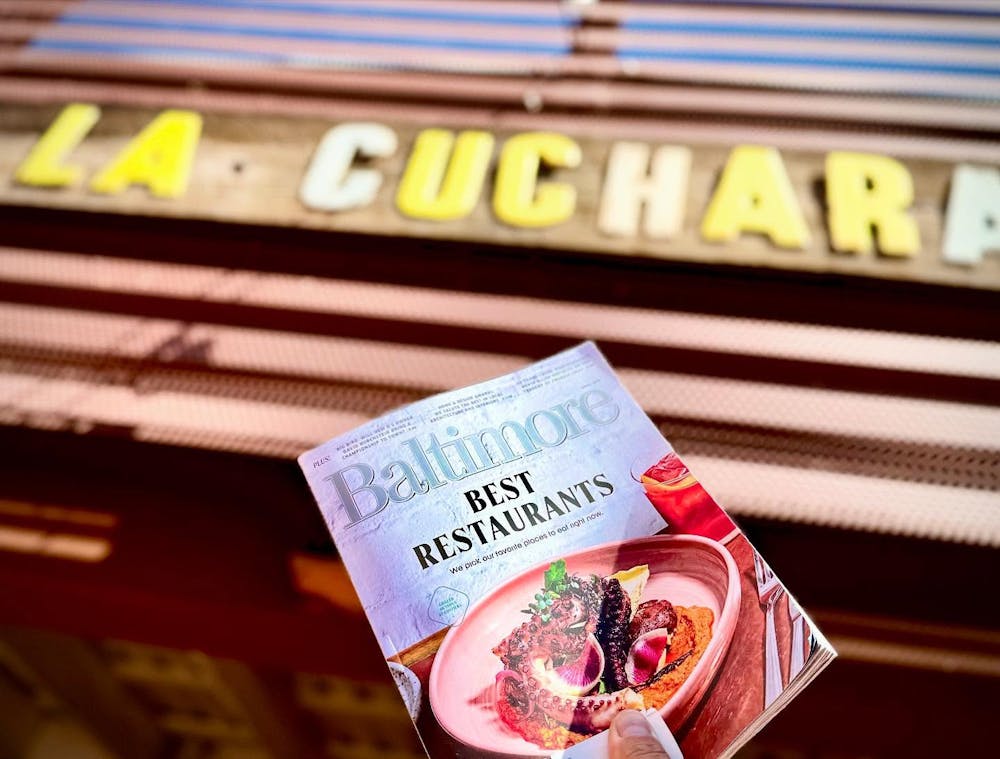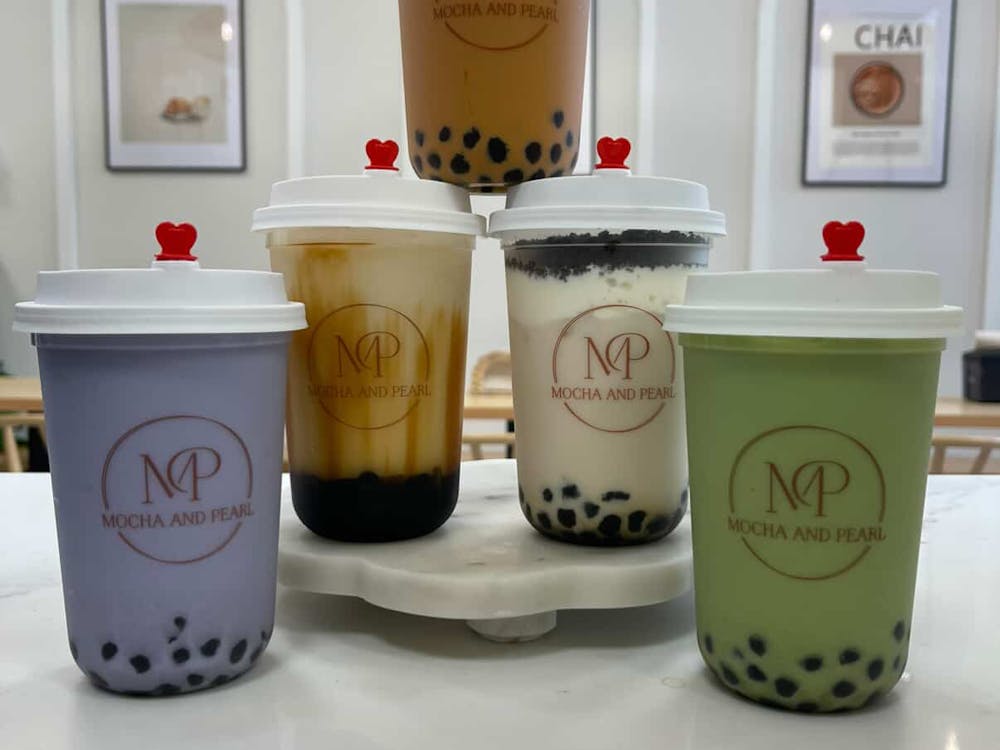La Cuchara co-owner Jake Lefenfeld shares how he and his family transformed a historic space in Meadow Mill into a restaurant that brings the culinary wonders of Spain and southern France to Baltimore through the vibrant flavors of the Basque region. At La Cuchara, guests are invited to savor seasonal dishes and handcrafted drinks, discovering something new and exciting with every visit.
The News-Letter: Many students recommended La Cuchara when I first started college, and it’s been one of my favorite spots over the past three years!
Let’s start from the beginning. We know your journey began at Fish Tales in Ocean City and took you through a number of restaurants in Baltimore, before you co-founded La Cuchara with your family. How have those past experiences shaped your approach to mixology and hospitality?
JL: Working in different types of establishments taught me a lot. Each place had its own style, its own group of guests, and that really helped me learn how to build relationships and make sure every guest has a great time. Fish Tales was very different from Black Olive, for example — more of a beach party vibe — and there I learned important management skills that have been incredibly helpful as my career developed.
N-L: La Cuchara has been a champion of amazing Basque cuisine in Baltimore. Why did you all decide to focus on Basque cuisine? And what’s the story behind the name "La Cuchara"?
JL: For the name, "La Cuchara" means "the spoon" in Spanish, but it also reflects the idea of gathering around a pot of stew and sharing a meal made with whatever you have on hand. A lot of cultures have something similar. When we traveled around Europe, the whole family fell in love with the asador restaurants, the pintxo bars, and, really, the entire Basque region and its people. They’re so warm, talented and loving. And the Basque region also has one of the highest concentrations of innovative cooking anywhere in the world over the past few decades.
N-L: Running a restaurant with family must be a very unique experience. How do you, your brother Ben and your sister-in-law Amy divide responsibilities at La Cuchara?
JL: We’re lucky — we really trust each other and work toward the same goal. Each of us brings different skills to the table. Amy is amazing with the business side and finance, Ben is obviously an incredible chef, and I focus on front-of-house and hospitality. We complement each other really well. It’s a great partnership; we each bring different strengths to the table, and, together, it works beautifully.

COURTESY OF LA CUCHARA
The Lefenfeld family weaves together Basque flavors and Baltimore charm.
N-L: That sounds like such a healthy and complementary partnership! Speaking of the space itself, La Cuchara is located in a historic building at Meadow Mill. What drew you to that location, and how has the building’s character influenced the restaurant’s atmosphere?
JL: We loved the historic nature of the building; you can feel the history the moment you walk in. Even before it was the London Fog factory, it had an industrial life going all the way back to the 1800s. We wanted to put roots down somewhere with deep Baltimore ties but that also has a unique feel compared to other places in the city — plus, it has great parking!
N-L: That sounds wonderful; I love the vibe that mixes modern and retro! Moving into the day-to-day, what’s your favorite part of running La Cuchara, and what’s the most challenging?
JL: One of my favorite parts is working on the cocktail and beverage program. I love starting my day by looking at the cocktail and wine lists; that’s where I really get to put a personal touch and create something for our guests. Another thing I love is seeing our regular guests — being able to chat with them, host them — and also meeting new guests. It’s definitely a highlight of my day.
As for challenges, running a small business always means you have to pivot constantly. Between COVID-19 and general market changes, there’s always something new to adapt to. I don’t dislike it, but it’s definitely a challenge. You always have to identify problems quickly and adjust how you operate to meet those new challenges.
For example, during COVID-19, we created a marketplace to sell goods directly to the community; that helped us keep the lights on. More recently, we’ve had to adjust how we source products due to supply chain issues, making sure we can continue to offer high-quality dishes and drinks at fair prices. It’s always a balancing act.
N-L: La Cuchara is known for changing its menu daily, focusing on fresh seasonal ingredients. How do you apply that philosophy to the beverage program?
JL: Being able to reprint the menu each day gives me the freedom to be really creative with the cocktails, too. If I have a special ingredient for one night only, that’s great — I can make a one-night-only cocktail. Every day is a new seasonal list because I can tweak, swap or completely recreate cocktails whenever I want. It’s incredible to have that level of flexibility.
We also have a "G&T de Jour" — a gin and tonic of the day — where my bartenders use whatever fresh produce or ingredients we get from the kitchen that day. It keeps things exciting, both for us and for the guests.
We work with a lot of wonderful local producers, too — for example, Karma Farm. Being able to visit the farms, see how everything is grown and bring it right to the restaurant makes it extra special. There’s a real connection between the farm and the table, and guests can taste that.
N-L: I love the transparency and connection that brings. Also, as the creative force behind the beverage program, where do you usually find inspiration for your cocktails?
JL: I’m really inspired by cocktails from the 1920s and ‘30s. Some of them translate directly to today, and others I like to put a modern twist on. I love taking a classic and either presenting it just as it was 100 years ago or reimagining it with a fresh spin.
One of my favorites is the Ramos Gin Fizz — it’s a green-based cocktail that takes about five to ten minutes to prepare properly, but it’s so rewarding. I love the history behind classic cocktails and the journey of bartending over the past century; it’s something beautiful to remember and carry forward.
Even today, many of the spirits we use are the same ones they used 100 years ago. Whether I’m treating them traditionally or giving them a new twist, it’s always fun to showcase that connection.
N-L: I definitely need to try one next time! How do you research these recipes?
JL: Honestly, you don’t find everything on the Internet. I collect old cocktail books — some from the 1940s — and study them. The more knowledge you have about history and technique, the more you’re able to create. It’s a lot of trial and error too; sometimes, I’ll work on a cocktail six or seven times until I get it right.
N-L: Could you share a story behind one of your favorite cocktails you’ve created?
JL: Sure! One is called Miss May. I created it for my wife; she loved the flavor of bourbon but found it a little too strong. So, I blended bourbon aged in port barrels with a 23-year aged rum, mole bitters, orange peel and cardamaro, a liqueur made from cardoon plants. It turned into a smoother, slightly sweeter drink that kept the spirit of bourbon.
Another one I love is Sangre del Corazón, which means "Blood of the Heart" in Spanish. We had fresh beets coming in, and I didn’t want them to go bad. I turned them into a sweet beet espuma — like a foam — and topped a black pepper-infused gin and tonic with it. It’s a seasonal item, and we’ll actually be bringing it back this May!
N-L: I’ll definitely keep an eye out for it! Now, for guests who are newer to pairing food and drinks, what advice would you give?
JL: My advice is to not limit yourself to one type of drink, and trust your server! You might start with a cocktail and some almonds or olives, move to a rosé with your first course and maybe try a nice sherry with your charcuterie. There’s a whole world of options out there, and part of the fun is exploring them throughout the meal.

COURTESY OF LA CUCHARA
La Cuchara’s sommelier "Red" guides patrons to their perfect beverage pairing.
N-L: That’s great advice. Do you have a system for learning guests’ preferences when recommending cocktails?
JL: I always ask them what they’ve enjoyed in the past. Are they looking for something sweeter, more vegetal, more savory? Then I design something based on their answers. You don’t just make someone a margarita because they say they like tequila; you want to create something new and memorable, something that shows you listened and crafted something special for them. That’s what hospitality is all about.
N-L: That’s amazing! Finally, I heard the exciting news that your family recently purchased the old Five and Dime building in Hampden. What’s your vision for that space?
JL: We’re really excited! We’ll continue to run La Cuchara, of course, but we’re hoping to launch a brand-new concept in the Five and Dime space soon. Hampden is such a great community; there are so many great restaurants already, and we’re excited to be part of that neighborhood with a new project. The building itself has so much historic value, and we can’t wait to breathe some new life into it.





